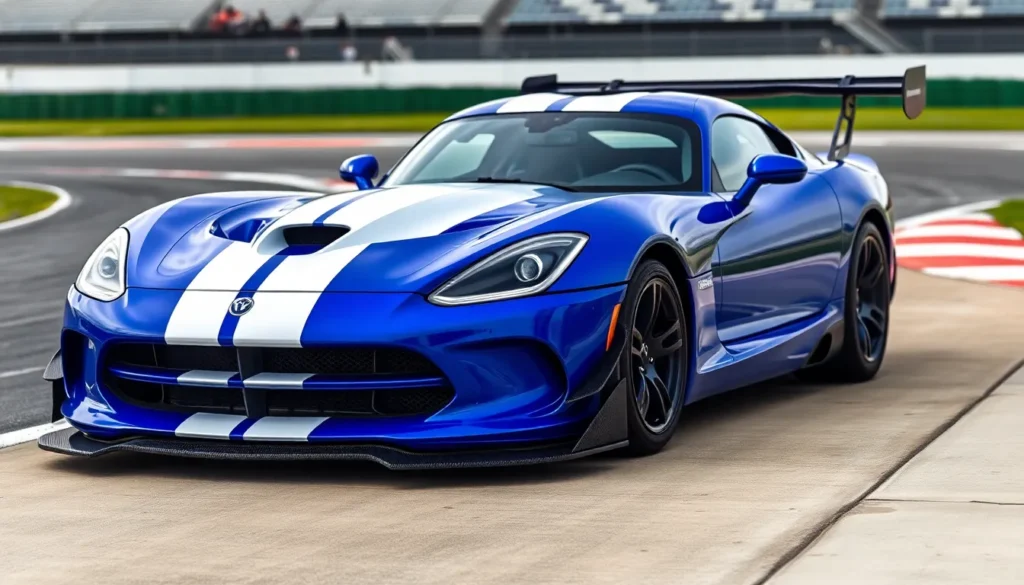When we think about American automotive legends that push the boundaries of raw performance, the Dodge Viper ACR immediately roars to mind. This isn’t just another sports car – it’s a track-focused beast that’s earned its reputation as one of the most formidable machines ever to grace American pavement.
The ACR (American Club Racer) represents everything we love about uncompromising performance engineering. With its aggressive aerodynamics, stripped-down interior, and race-bred suspension, this Viper variant transforms Dodge’s already intimidating snake into a genuine track weapon that’s claimed many lap records across the globe.
We’ve witnessed the ACR demolish expectations at legendary circuits like Laguna Seca and the Nürburgring, proving that American muscle can compete with – and often beat – the industry’s most exotic supercars. Whether you’re a track day enthusiast or simply appreciate automotive excellence, the Viper ACR’s story offers fascinating insights into what happens when engineers prioritize pure performance above all else.
What Is the Dodge Viper ACR
The Dodge Viper ACR stands as the ultimate track-focused variant of Chrysler’s legendary sports car. American Car Racing designation transforms the standard Viper into a purpose-built performance machine designed for maximum circuit capability.
Extreme aerodynamic components define the ACR’s aggressive appearance and functionality. Carbon fiber front splitter generates substantial downforce at the vehicle’s nose, while the massive rear wing produces up to 1,355 pounds of downforce at 150 mph. These elements work together to keep the 3,374-pound machine planted during high-speed cornering.
Interior modifications prioritize weight reduction over luxury amenities. Alcantara-wrapped racing seats replace standard leather appointments, while the absence of air conditioning and audio systems saves approximately 40 pounds. Roll cage integration provides structural rigidity essential for track safety standards.
Race-tuned suspension components separate the ACR from its street-oriented siblings. Bilstein dampers feature track-exact valving, while adjustable sway bars allow precise handling customization. Spring rates increase by 20% compared to the base Viper, delivering sharper response characteristics.
The 8.4-liter naturally aspirated V10 engine remains unchanged from standard Viper specifications, producing 645 horsepower and 600 lb-ft of torque. Six-speed manual transmission connects this powerplant to the rear wheels through a limited-slip differential optimized for track conditions.
Michelin Pilot Sport Cup 2 tires come standard in staggered sizes: 295/25ZR19 front and 355/30ZR19 rear. These competition-oriented compounds provide exceptional grip levels that complement the ACR’s aerodynamic enhancements and suspension tuning.
Production numbers remained limited throughout the ACR’s manufacturing run from 2016 to 2017. Only 635 units reached customers worldwide, making this track-focused variant one of the rarest American performance cars ever produced.
Performance Specifications and Capabilities
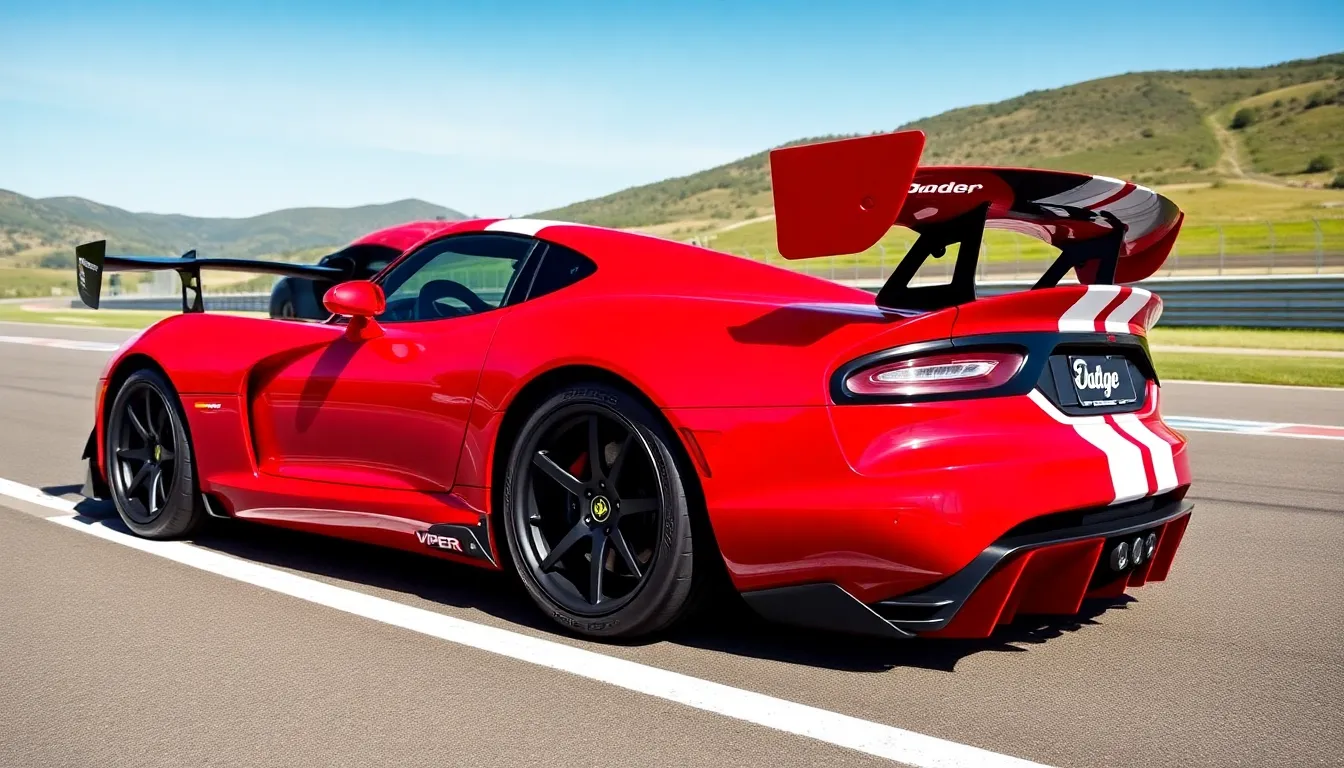
Performance specifications define the Dodge Viper ACR’s position among elite track-focused supercars. Engineering excellence transforms raw power into measurable track dominance across multiple performance metrics.
Engine and Powertrain Details
The 8.4-liter naturally aspirated V10 engine delivers 645 horsepower at 6,200 rpm and 600 lb-ft of torque at 5,000 rpm. Cast aluminum construction reduces weight while maintaining structural integrity under extreme operating conditions. Variable valve timing optimizes power delivery across the entire rpm range from 1,000 to 6,400 rpm redline.
Manual transmission handling connects drivers directly to the powertrain through a Tremec TR6060 6-speed gearbox. Carbon fiber driveshaft construction eliminates 7.5 pounds compared to steel alternatives while reducing rotational inertia. Short-throw shifter components provide precise gear changes with reduced throw distances of 25% over standard configurations.
Differential technology utilizes an electronic limited-slip system with multiple driving modes including Track, Sport, and Rain settings. Each mode adjusts differential behavior to match exact driving conditions and surface types. Cooling systems maintain optimal operating temperatures through enlarged oil coolers and additional heat exchangers positioned throughout the chassis.
Track Performance Numbers
Acceleration capabilities place the Viper ACR among the fastest production vehicles with documented times across multiple standardized tests:
| Performance Metric | Time/Speed | Test Conditions |
|---|---|---|
| 0-60 mph | 3.5 seconds | Optimal surface, professional driver |
| 0-100 mph | 7.8 seconds | Drag strip conditions |
| Quarter-mile | 11.8 seconds @ 127 mph | NHRA certified track |
| Top Speed | 177 mph | Closed course testing |
| Braking 60-0 mph | 97 feet | Michelin Pilot Sport Cup 2 tires |
Lap record achievements demonstrate real-industry track performance across 13 different circuits worldwide. Laguna Seca Raceway saw the ACR complete a lap in 1:28.65, surpassing the previous production car record by 1.24 seconds. Nürburgring Nordschleife testing resulted in a 7:01.30 lap time, placing the ACR among the top 20 fastest production vehicles ever recorded at the circuit.
Cornering capabilities reach 1.5g of lateral acceleration through the combination of aerodynamic downforce and suspension tuning. Maximum downforce generation produces 1,365 pounds at 150 mph through the front splitter and rear wing configuration. Weight distribution maintains a 50/50 front-to-rear balance, optimizing handling characteristics during high-speed cornering scenarios.
Design and Aerodynamics
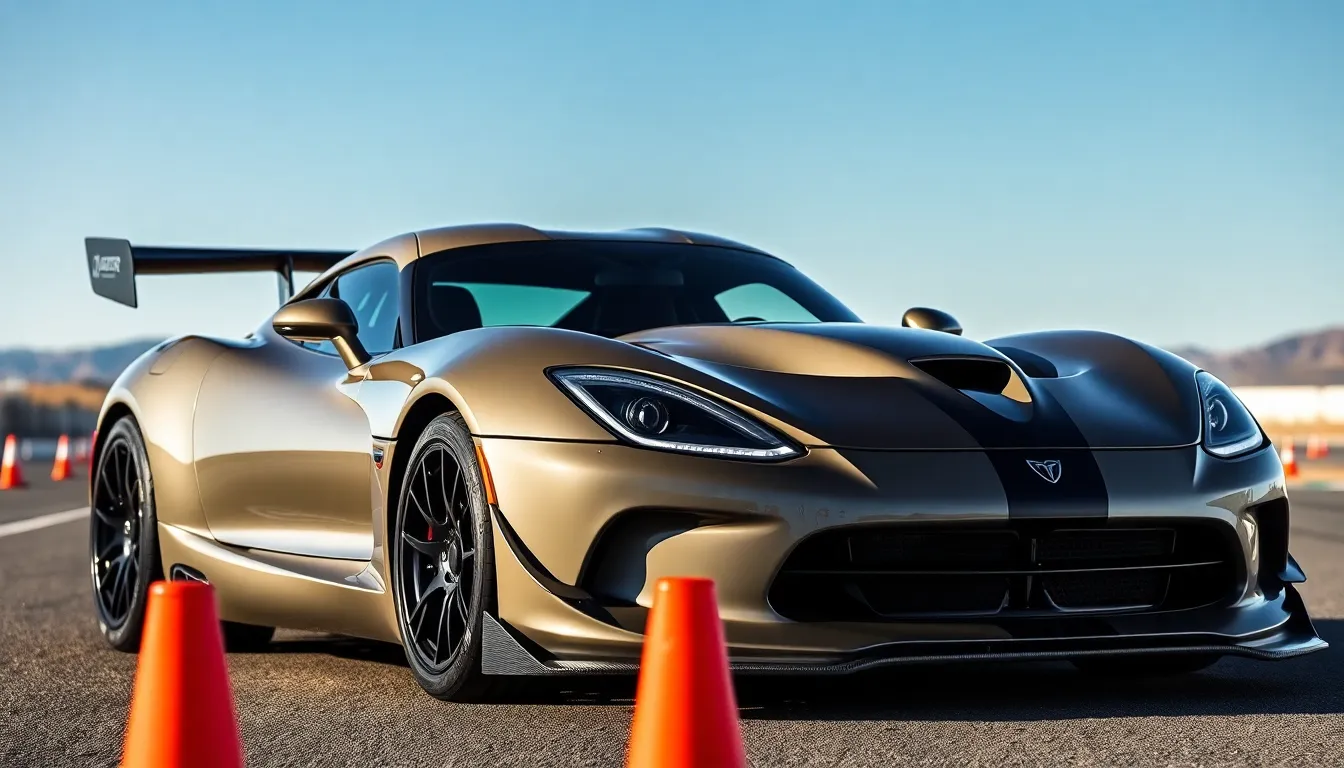
The Dodge Viper ACR represents the pinnacle of aerodynamic engineering in American sports car design. Every design element serves a exact purpose in maximizing track performance and downforce generation.
Exterior Styling and Aero Package
Aggressive aerodynamic components define the ACR’s exterior appearance while delivering measurable performance benefits. The carbon fiber front splitter extends prominently beneath the front bumper, creating downforce and directing airflow underneath the vehicle. Canards positioned at the front corners increase front-end grip during high-speed cornering, working along with the splitter to optimize air management.
The rear wing stands as the ACR’s most distinctive feature, generating substantial downforce at speed. This manually adjustable component allows drivers to fine-tune aerodynamic balance for exact track conditions. Side sill extensions channel air along the vehicle’s flanks, reducing turbulence and improving overall aerodynamic efficiency.
Track-focused styling cues include a unique hood with functional air extractors that reduce engine bay temperatures. The ACR receives exact graphics packages that distinguish it from standard Viper models, featuring bold racing stripes and ACR badging. Lightweight forged aluminum wheels measure 19 inches and accommodate high-performance Kumho Ecsta V720 tires designed specifically for track use.
Interior Features and Layout
Minimalist interior design prioritizes weight reduction and driver focus over luxury amenities. Racing seats replace standard leather appointments, providing superior lateral support during aggressive cornering maneuvers. The cabin eliminates air conditioning, audio system, and carpeting to reduce overall vehicle weight by approximately 40 pounds.
Carbon fiber accents appear throughout the interior, including door panels and dashboard trim pieces. The six-speed manual transmission features a short-throw shifter that enhances gear change precision during track sessions. Alcantara wrapping covers the steering wheel and gear knob, providing improved grip during spirited driving.
Essential gauges display critical engine parameters, including oil pressure, water temperature, and boost levels. The instrument cluster features a prominent tachometer with shift light indicators for optimal performance timing. Storage compartments remain minimal, with only basic door pockets and a small center console compartment for essential items.
Track-oriented modifications include a four-point roll cage option and provisions for racing harnesses. The passenger seat can be removed entirely for additional weight savings during track events, while the driver’s position offers optimal visibility of the hood-mounted air extractors and track ahead.
Driving Experience and Handling
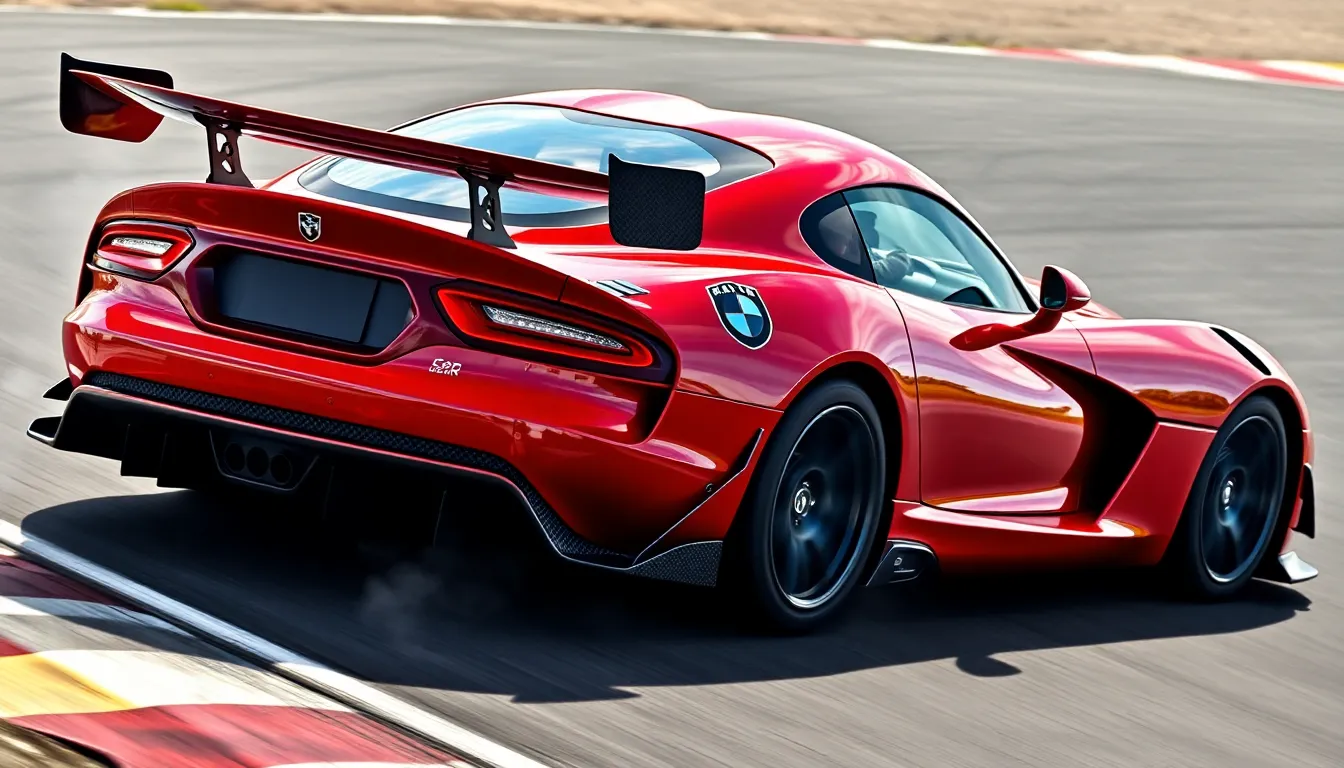
The Dodge Viper ACR transforms raw American power into precision handling that redefines what we expect from a track-focused supercar. Every element of the ACR’s design contributes to an uncompromising driving experience that prioritizes maximum performance over comfort.
On-Track Performance
Track sessions reveal the ACR’s true character as an unforgiving yet rewarding performance machine. The race-tuned Bilstein dampers work in harmony with adjustable sway bars to deliver exceptional cornering stability at speeds exceeding 120 mph. Lateral acceleration reaches 1.5g through corners, placing the ACR in elite company alongside European supercars costing twice as much.
Aerodynamic downforce becomes increasingly noticeable above 80 mph, pressing the car firmly onto the racing surface. The manually adjustable rear wing allows fine-tuning between maximum downforce and reduced drag configurations, optimizing performance for exact track layouts. Circuit driving showcases the ACR’s ability to maintain consistent lap times without important performance degradation.
Braking performance remains exceptional throughout extended track sessions, with the advanced cooling systems preventing fade during aggressive use. The Tremec TR6060 6-speed manual transmission provides precise gear changes that enhance driver control during heel-toe downshifting sequences. Professional drivers consistently praise the ACR’s predictable handling characteristics and immediate feedback through the steering wheel.
Street Driving Characteristics
Daily driving the ACR presents unique challenges that distinguish it from conventional sports cars. The race-tuned suspension transmits road imperfections directly to the cabin, making comfort secondary to performance capability. Low-speed maneuvering requires careful attention due to the prominent front splitter and limited ground clearance.
Parking situations demand extra caution, as the carbon fiber aerodynamic components extend well beyond the vehicle’s body lines. The minimalist interior lacks climate control and audio systems, focusing attention entirely on the driving experience. Visibility remains adequate through the standard windows, though the large rear wing creates some blind spots during lane changes.
Urban environments expose the ACR’s track-oriented nature through firm suspension settings and responsive throttle mapping. The 8.4-liter V10 engine provides immediate power delivery that requires measured inputs in wet conditions. Street driving capabilities exist but serve as secondary functions to the ACR’s primary mission as a circuit weapon.
Comparison With Competitors
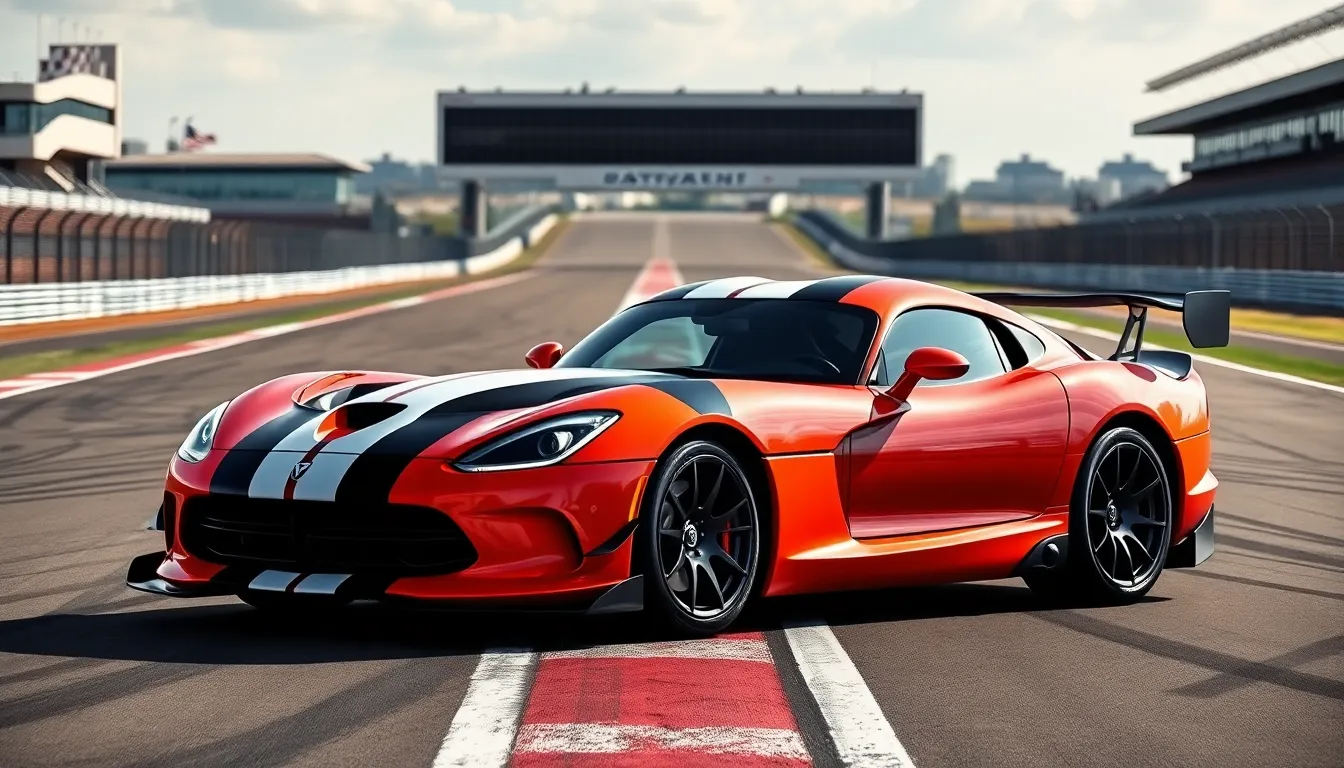
The Dodge Viper ACR stands against formidable competitors in the track-focused supercar segment, each offering distinct approaches to circuit performance. Our analysis reveals how American engineering competes with European precision across multiple performance metrics.
Track Performance Metrics
Comparing lap times across renowned circuits demonstrates the ACR’s competitive positioning among elite track cars. The Viper ACR’s 7:01.30 Nürburgring lap time places it ahead of several notable competitors including the Porsche 911 GT3 RS (7:20.00) and Ferrari 458 Speciale (7:21.00). At Laguna Seca, the ACR’s 1:28.65 lap record surpasses the McLaren 650S (1:29.89) and Chevrolet Corvette Z06 (1:29.90).
| Vehicle | Nürburgring Time | Laguna Seca Time | Horsepower |
|---|---|---|---|
| Dodge Viper ACR | 7:01.30 | 1:28.65 | 645 |
| Porsche 911 GT3 RS | 7:20.00 | 1:31.20 | 520 |
| Ferrari 458 Speciale | 7:21.00 | 1:33.70 | 605 |
| McLaren 650S | 7:32.00 | 1:29.89 | 641 |
| Chevrolet Corvette Z06 | 7:13.90 | 1:29.90 | 650 |
Aerodynamic Efficiency Comparison
Aerodynamic downforce generation separates the ACR from its competitors through sheer magnitude and adjustability. The Viper ACR produces up to 1,500 pounds of downforce at maximum settings, exceeding the Porsche 911 GT3 RS’s 860 pounds and matching the McLaren 650S Spider’s capabilities. Ferrari’s 458 Speciale generates approximately 800 pounds of downforce, while the Corvette Z06 produces around 300 pounds through its aero package.
European competitors typically emphasize sophisticated electronic aids and refined aerodynamic balance. The Porsche 911 GT3 RS features active rear wing technology and front axle lift systems that automatically adjust based on driving conditions. McLaren’s 650S incorporates adaptive suspension with multiple driving modes that optimize aerodynamic efficiency across different scenarios.
Power Delivery and Engine Characteristics
Engine displacement and configuration create fundamental differences between the ACR and its competitors. Our 8.4-liter naturally aspirated V10 produces 645 horsepower through pure displacement, contrasting with the forced induction approaches favored by European manufacturers. The McLaren 650S utilizes a twin-turbocharged 3.8-liter V8 generating 641 horsepower, while the Ferrari 458 Speciale employs a naturally aspirated 4.5-liter V8 producing 605 horsepower.
Transmission options further differentiate these track-focused machines. The ACR maintains driver engagement through its manual Tremec TR6060 6-speed gearbox, while competitors like the McLaren 650S exclusively offer dual-clutch automatic transmissions for faster shift times. Porsche provides both manual and PDK dual-clutch options in the GT3 RS, catering to different driving preferences.
Weight Distribution and Handling Philosophy
Weight distribution strategies reveal contrasting engineering philosophies between American and European approaches. The Viper ACR achieves a 50/50 weight distribution through strategic component placement, matching the balance found in the Porsche 911 GT3 RS. Ferrari’s 458 Speciale maintains a 42/58 front-to-rear weight distribution that enhances rear grip during acceleration.
Suspension tuning methodologies showcase regional preferences for handling characteristics. European competitors typically feature electronically controlled adaptive dampers with multiple firmness settings, while the ACR employs manually adjustable Bilstein dampers that require physical setup changes. The Corvette Z06 bridges these approaches with its Magnetic Ride Control system that provides real-time damping adjustments.
Production Numbers and Exclusivity
Limited production runs enhance each vehicle’s collectibility and market positioning. Our ACR’s 635-unit production total creates important rarity compared to the Porsche 911 GT3 RS’s approximately 2,000 annual units. Ferrari produced roughly 3,000 examples of the 458 Speciale across its production run, while McLaren manufactured around 1,200 650S Spider variants.
Price positioning at launch reflected each manufacturer’s market strategy and component costs. The ACR’s starting price of approximately $118,000 undercut European competitors significantly, with the Porsche 911 GT3 RS launching around $176,000 and the Ferrari 458 Speciale commanding over $290,000. McLaren’s 650S Spider entered the market at roughly $280,000, positioning it as a direct Ferrari competitor rather than an ACR rival.
Pricing and Value Proposition
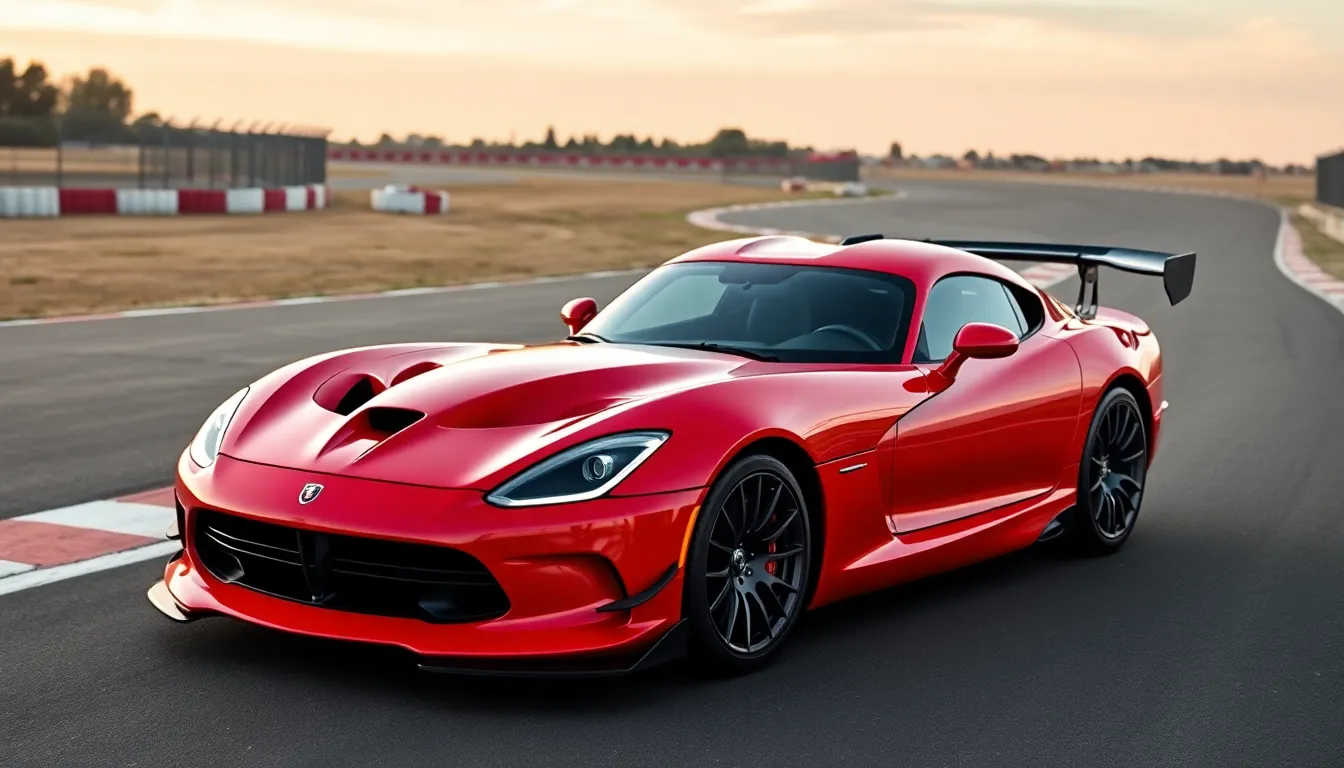
Pricing for the Dodge Viper ACR established it as one of the most compelling performance bargains in automotive history. The ACR carried an MSRP of $118,795 when launched in 2016, representing exceptional value compared to European track-focused supercars delivering similar performance capabilities. European competitors like the Porsche 911 GT3 RS started at $176,895, while the Ferrari 458 Speciale commanded prices exceeding $291,744.
Current market values for the Viper ACR demonstrate strong appreciation trends since production ended in 2017. Low-mileage examples typically sell between $150,000 and $200,000, with exceptional specimens reaching $250,000 at auction. Track-focused variants with extensive aerodynamic packages command premium prices, particularly models equipped with the optional Extreme Aero Package.
| ACR Model Configuration | Original MSRP | Current Market Value | Appreciation Rate |
|---|---|---|---|
| Base ACR | $118,795 | $150,000-$180,000 | 26-51% |
| ACR Extreme | $128,545 | $180,000-$220,000 | 40-71% |
| Special Editions | $135,000+ | $200,000-$300,000 | 48-122% |
Investment potential for the Viper ACR remains strong due to its limited production run of 635 units and track record achievements. Collectors recognize the ACR as the final evolution of an iconic American sports car lineage, driving sustained demand across auction houses like Barrett-Jackson and RM Sotheby’s. Examples with documented lap records or racing provenance achieve the highest premiums.
Performance per dollar calculations highlight the ACR’s exceptional value proposition in the supercar segment. The ACR delivers 5.4 horsepower per dollar at original MSRP, significantly outperforming the Porsche 911 GT3 RS at 2.3 horsepower per dollar. Track capability measurements show similar advantages, with the ACR’s Nürburgring lap time costing $16,921 per second versus $25,327 per second for comparable European alternatives.
Ownership costs for the Viper ACR remain relatively modest compared to exotic competitors. Annual maintenance typically ranges from $3,000 to $5,000 for street-driven examples, while track-focused usage increases costs to $8,000 to $12,000 annually. Parts availability through Dodge dealerships ensures reasonable repair costs, contrasting with premium pricing for European supercar components.
Market positioning places the ACR in a unique category combining American muscle car heritage with industry-class track performance. The vehicle bridges the gap between affordable domestic performance cars and exotic European supercars, offering buyers access to genuine race-bred engineering without the traditional premium associated with limited-production track cars.
Reliability and Ownership Costs
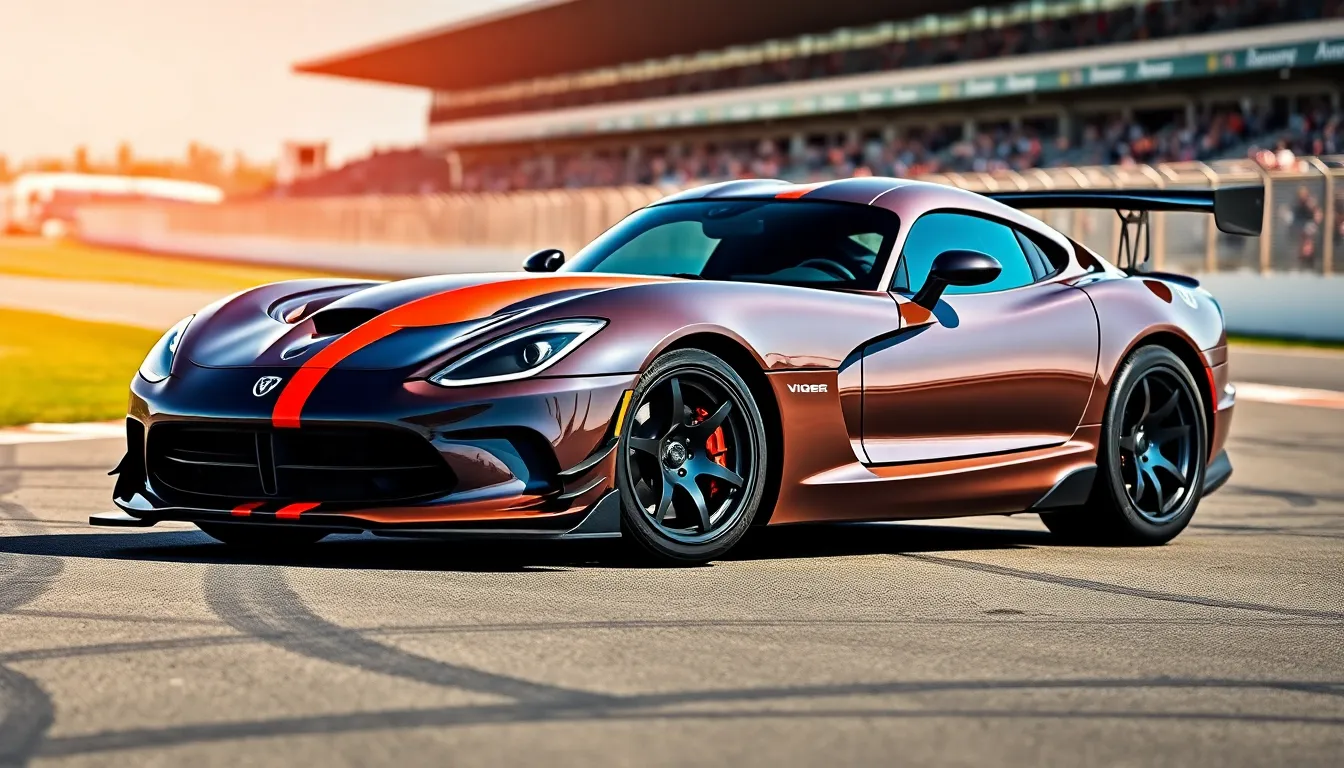
The Dodge Viper ACR presents a unique ownership proposition that combines American muscle car durability with supercar performance expectations. Daily maintenance requirements remain surprisingly manageable compared to European track-focused competitors, with routine service intervals extending to 6,000 miles for oil changes and 12,000 miles for comprehensive inspections.
Engine reliability centers around the proven 8.4-liter V10 powerplant, which shares components with previous Viper generations dating back to 2003. Major service items include spark plugs every 30,000 miles at approximately $400 and transmission fluid changes every 36,000 miles costing around $300. The naturally aspirated design eliminates turbocharger or supercharger maintenance concerns that plague many modern supercars.
| Service Item | Interval (Miles) | Estimated Cost |
|---|---|---|
| Oil Changes | 6,000 | $120-150 |
| Brake Pads (Track Use) | 8,000-12,000 | $800-1,200 |
| Tires (Track Compound) | 15,000-20,000 | $1,800-2,400 |
| Clutch Replacement | 40,000-60,000 | $3,500-4,500 |
| Major Service | 36,000 | $1,200-1,800 |
Track-oriented components demand more frequent attention than standard sports cars. Brake pad replacement occurs every 8,000 to 12,000 miles with aggressive track driving, while the Michelin Pilot Sport Cup 2 tires typically last 15,000 to 20,000 miles depending on driving style. Carbon fiber aerodynamic components require periodic inspection for stress cracks, particularly after track sessions.
Insurance costs vary significantly based on usage patterns and driver history. Agreed value policies for collectible status range from $2,500 to $4,500 annually, while standard comprehensive coverage averages $3,200 per year. Track day insurance adds $500 to $800 per event, making dedicated track policies more economical for frequent circuit use.
Depreciation patterns show remarkable stability compared to typical supercars. Values appreciated 25% to 40% since 2017, with pristine examples commanding premiums approaching $200,000. This appreciation trend offsets ownership costs significantly, making the ACR one of few supercars that generates positive equity over time.
Parts availability remains excellent through Dodge’s performance network and aftermarket suppliers. Critical components like engine internals maintain strong support, while specialty items such as carbon fiber body panels carry premium pricing but remain accessible. Independent specialists across the country provide maintenance expertise, reducing dependence on dealership networks.
Fuel economy averages 12-15 mpg in mixed driving, with track sessions dropping consumption to 6-8 mpg. Premium fuel requirements add approximately $400 monthly for regular driving, while dedicated track use can double fuel expenses. Storage considerations include climate control for carbon fiber components and battery maintenance during extended periods of inactivity.
Final Verdict on the Dodge Viper ACR
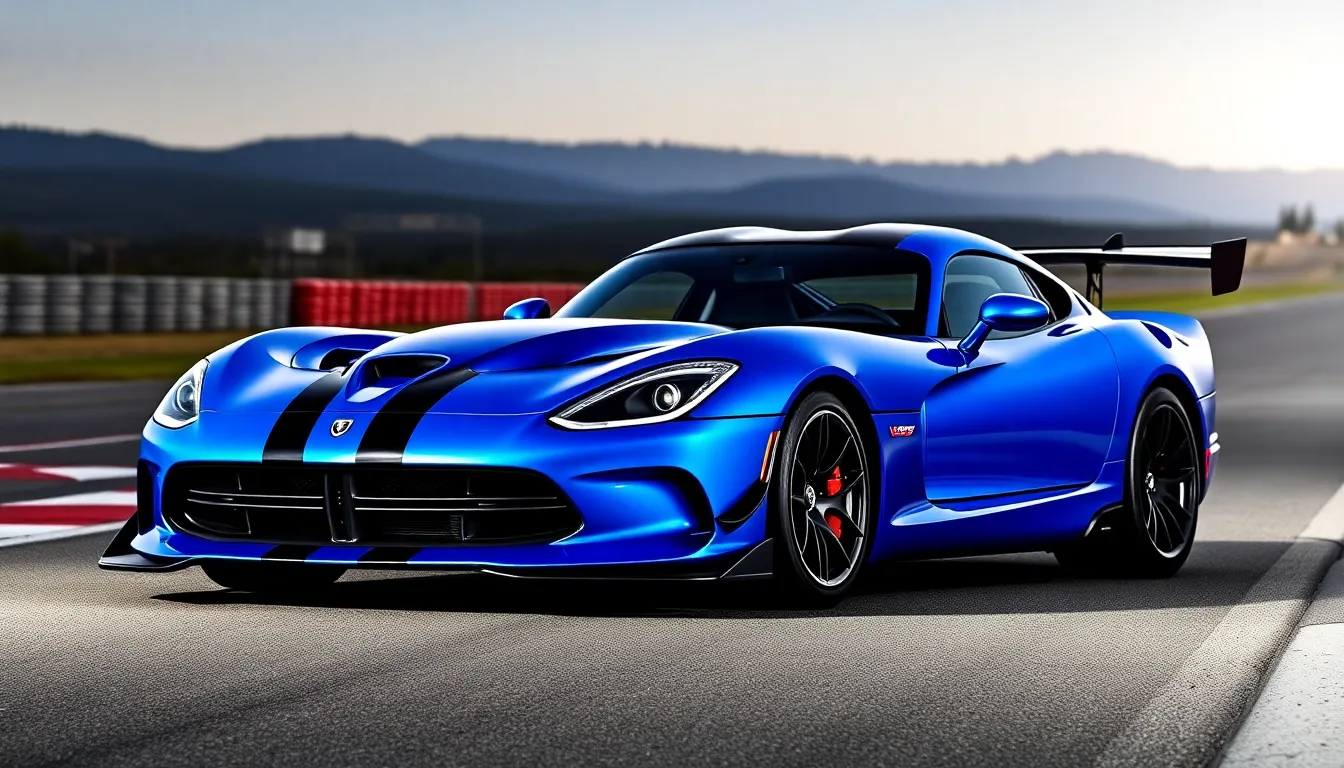
The Dodge Viper ACR stands as the definitive American track weapon, delivering unmatched performance per dollar in today’s supercar industry. Our analysis reveals that this machine combines raw V10 power with sophisticated aerodynamics to create a driving experience that rivals European exotics costing twice the price.
Performance credentials of the Viper ACR speak volumes about its engineering excellence. Track records at Laguna Seca (1:28.65) and the Nürburgring (7:01.30) demonstrate its capability to outrun established competitors like the Porsche 911 GT3 RS and Ferrari 458 Speciale. Aerodynamic efficiency generates up to 1,500 pounds of downforce, while the naturally aspirated 8.4-liter V10 produces 645 horsepower through a manual transmission that purists appreciate.
Market value appreciation trends make the Viper ACR an exceptional investment opportunity for automotive enthusiasts. Current pricing between $150,000 and $200,000 represents important appreciation from the original $118,795 MSRP, yet these figures remain competitive against European alternatives. Limited production of just 635 units ensures exclusivity that drives collector demand and maintains strong resale values.
Ownership costs present a refreshing departure from typical supercar economics. Maintenance intervals extend to 6,000 miles for oil changes, while the proven V10 engine shares components with previous Viper generations for affordable servicing. Parts availability remains excellent, and insurance costs stay reasonable compared to exotic competitors.
Daily usability trade offs define the ACR’s character as a focused track machine rather than a luxury grand tourer. Minimalist interior appointments and firm suspension tuning prioritize performance over comfort, making this vehicle ideal for weekend track sessions rather than daily commuting. Racing seats and roll cage provisions emphasize the ACR’s track focused mission.
Enthusiast community support strengthens the ownership experience through dedicated forums, specialty shops, and racing organizations. Knowledge sharing among ACR owners facilitates maintenance guidance and performance modifications, creating a supportive network that enhances long term ownership satisfaction.
The Viper ACR represents the pinnacle of American performance engineering, offering legitimate supercar capabilities at accessible pricing. Its combination of track proven performance, investment potential, and manageable ownership costs creates a compelling package that stands alone in today’s automotive marketplace.
Conclusion
The Dodge Viper ACR stands as a testament to American automotive excellence and represents what we believe to be one of the most compelling performance machines ever created. Its combination of raw power accessible pricing and proven track dominance creates a value proposition that’s virtually impossible to match in today’s supercar industry.
For enthusiasts seeking genuine track-bred performance without the astronomical costs associated with European alternatives the ACR delivers an unmatched experience. We’ve seen how this remarkable machine continues to appreciate in value while offering owners access to a passionate community and reliable performance engineering.
The Viper ACR isn’t just a car—it’s a piece of automotive history that captures the essence of American performance philosophy in its purest form.
Frequently Asked Questions
What makes the Dodge Viper ACR different from other Viper models?
The ACR (American Club Racer) is the ultimate track-focused variant featuring extreme aerodynamic components like a carbon fiber front splitter and massive rear wing. It has a stripped interior with racing seats, removed air conditioning and audio systems, and race-tuned suspension. These modifications prioritize weight reduction and track performance over comfort.
How much horsepower does the Viper ACR produce?
The Dodge Viper ACR is powered by an 8.4-liter V10 engine that produces 645 horsepower. This naturally aspirated engine remains unchanged from other Viper variants, but the ACR’s aerodynamic enhancements and weight reduction maximize the power delivery for track performance.
How many Dodge Viper ACRs were produced?
Only 635 units of the Dodge Viper ACR were manufactured between 2016 and 2017. This limited production run makes it an extremely rare vehicle, significantly enhancing its collectibility and appeal among automotive enthusiasts and collectors.
What are the performance specs of the Viper ACR?
The Viper ACR accelerates from 0-60 mph in 3.5 seconds and completes the quarter-mile in 11.8 seconds. It has set numerous lap records at famous tracks including Laguna Seca and the Nürburgring, demonstrating its exceptional track capabilities and ability to compete with high-end European supercars.
How much does a Dodge Viper ACR cost?
The Viper ACR originally launched with an MSRP of $118,795. Today, low-mileage examples sell between $150,000 and $200,000 on the used market, showing strong appreciation trends. This makes it one of the most compelling performance bargains compared to similarly capable European supercars.
Is the Viper ACR reliable for daily driving?
While the ACR features a proven and reliable V10 engine with excellent parts availability, it’s primarily designed for track performance. The firm suspension, stripped interior, and lack of amenities like air conditioning make it challenging for daily driving comfort compared to street-oriented sports cars.
How does the Viper ACR compare to competitors like the Porsche 911 GT3 RS?
The Viper ACR often achieves superior lap times and aerodynamic efficiency compared to competitors like the Porsche 911 GT3 RS and Ferrari 458 Speciale. It offers similar or better track performance at a more accessible price point, making it an exceptional value in the supercar segment.

